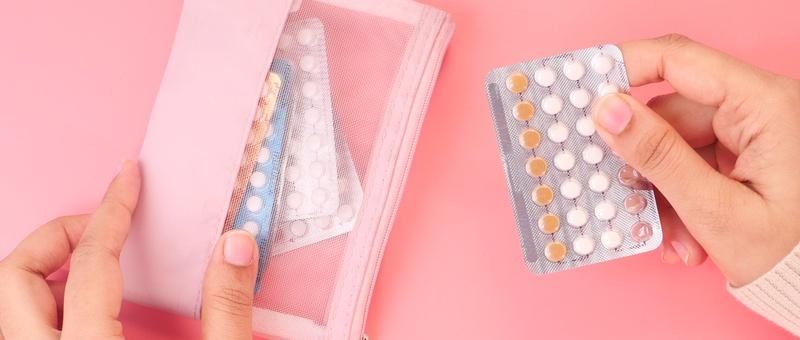
La pilule peut-elle prévenir les métrorragies ?
Révision par les pairs par le Dr Sarah Jarvis MBE, FRCGPDernière mise à jour par Natalie HealeyDernière mise à jour : 4 juin 2019
- TéléchargerTélécharger
- Partager
- Langue
- Discussion
Breakthrough bleeding on the combined pill is common - especially when you first start taking it, or if you choose to take it without a break. But is there anything you can do to prevent breakthrough bleeding like spotting? We ask a gynaecologist.
Dans cet article :
Poursuivre la lecture ci-dessous
Avoiding bleeds by taking the pill without a break
If you're using the combined oral contraceptive pill, you likely take a tablet every day for 21 days, followed by seven-day break for a bleed. That's the way it's currently licensed for use.
However, earlier this year, the Faculty of Sexual and Reproductive Healthcare (FSRH) published new guidance stating that this break was medically unnecessary. You can safely avoid monthly bleeding and the symptoms that come with it by running your pill packets together.
Benefits of taking the pill without a break
Reduced period symptoms - some women find symptoms associated with the withdrawal bleed, such as migraines, headaches and PMS, will be reduced.
Increased pill effectiveness - taking a break from the pill weakens the pill's ability to prevent preventing your ovaries from releasing an egg. This makes ovulation more likely if you miss any pills before or after the break.
Continuously taking the pill sounds like a solution then, since it means your bleeds will stop completely. However, it's common for those who embrace it to still experience breakthrough bleeding.
Why breakthrough bleeding happens on the pill
Consultant gynaecologist at Edinburgh University, Professor Sharon Cameron, notes that many women experience breakthrough bleeding when they first start taking the pill. "It should settle within three months, so if it's continuing you should go back and see your contraceptive provider."
She explains that taking the combined pill switches your ovaries off, and the hormones in the pill make the lining of the womb thicken up. Over time, the womb lining might start coming away. That's why you might experience light bleeding if you've been running your pill packets together.
Choix des patients pour Le contrôle des naissances
Poursuivre la lecture ci-dessous
How to prevent breakthrough bleeding on the pill
Cameron notes that some women are just more susceptible to breakthrough bleeding on the pill than others.
However, there are certain habits you can adopt to make it less likely:
Take the pill at the same time of day to maintain hormone levels in the body.
Check that other medications you take aren't interfering with the pill.
Stop taking the pill for four days to allow the womb lining to shed, and then start again.
If you opt for the 4-7 day break, this will not reduce the effectiveness of the contraceptive pill, Cameron explains.
"With a four-day rather than a seven-day break, there's less likelihood that the ovaries will wake up and for one of the eggs to develop enough for ovulation."
Si cette pause de quatre jours n'améliore pas les saignements, demandez conseil à votre médecin généraliste ou à un centre de santé sexuelle local.
Other causes of breakthrough bleeding
Missing the pill.
Diarrhoea and vomiting may prevent the pill from being absorbed properly.
Certain medications (including herbal preparations) may interact with the pill.
Smoking can make breakthrough bleeding more likely.
STIs such as chlamydia.
Tous ces scénarios peuvent diminuer l'efficacité de la pilule en tant que contraceptif.
Causes rares
Womb and cervical cancer.
If breakthrough bleeding on the pill isn't not normal for you, you should get it checked out by a doctor.
"There are some women who just seem to bleed on every sort of hormonal contraception, and that's because the methods we have don't entirely replicate what the natural cycle would do. But as long as there's nothing harmful going on, there are some women who are prepared to put up with it in order to have an effective method of contraception", explains Cameron.
Breakthrough bleeding and PMS
Many women experience mood swings around their period. So could breakthrough bleeding also be associated with PMS, even if you've been taking the same dose of hormones every day?
Anecdotal reports suggest feeling anxious or agitated when breakthrough bleeding occurs is common. But Cameron says the evidence for this is currently unclear.
"L'humeur et l'influence des hormones sont mal comprises - et bien sûr, la pilule est également utilisée pour traiter le syndrome prémenstruel", souligne-t-elle.
Si vous prenez une méthode contraceptive qui interrompt votre cycle naturel et vous donne une dose continue, il est difficile de comprendre pourquoi cela affecterait votre humeur. Mais certains chercheurs pensent que ces sautes d'humeur sont davantage liées à une certaine partie du cerveau qu'aux ovaires, révèle Cameron.
"Si une personne présentait ces symptômes sous la pilule et qu'ils sont gênants, cela vaut la peine d'essayer une autre combinaison de pilules pour voir si elle est plus efficace. Il existe de nombreuses combinaisons de pilules ou d'autres méthodes de contraception que l'on peut essayer".
Certaines femmes préfèrent également ne pas enchaîner les plaquettes de pilules par crainte des saignements monstres et des crampes qui les attendent lorsqu'elles finiront par faire une pause. Mais Cameron pense que cela ne devrait pas être une grande préoccupation.
"La prise continue de la pilule peut être bénéfique pour les femmes qui ont des saignements abondants lorsqu'elles ne prennent pas la pilule, car elle réduit la fréquence des saignements qui surviennent. Et pour certaines femmes, il est possible de passer une longue période sans avoir de saignements. En effet, cette combinaison d'hormones sur la muqueuse utérine n'entraîne qu'un épaississement très minime".
Historique de l'article
Les informations contenues dans cette page ont été évaluées par des cliniciens qualifiés.
4 Jun 2019 | Dernière version

Demandez, partagez, connectez-vous.
Parcourez les discussions, posez des questions et partagez vos expériences sur des centaines de sujets liés à la santé.

Vous ne vous sentez pas bien ?
Évaluez gratuitement vos symptômes en ligne
